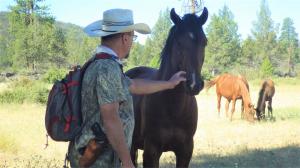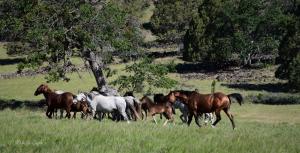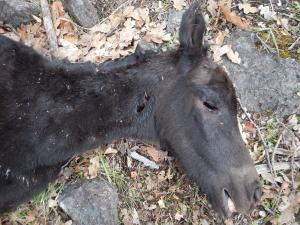New Research Reveals Natural Selection Has Many Facets Affecting Genetics & Foal Survival Of Wild Horses

A mighty wild mountain stallion greets naturalist and horse expert William E. Simpson II. Photo: Carla Bowers
Knowledge of previously unknown facets of evolutionary Natural Selection can provide enhanced, ecologically sustainable & cost-effective wild horse management
It's critical to understand that the process of evolutionary Natural Selection works perfectly and weeds-out weak genetics in herds of wild horses while regulating populations”
YREKA, CA, US, January 4, 2023 /EINPresswire.com/ -- There has been scant little funding that supports the critically important field research of free-roaming wild horses in the wilderness. — William E. Simpson II - Founder/Ex. Dir. Wild Horse Fire Brigade
So it's no wonder that so little is actually known about their behavioral ecology and ethology.
In order to truly study and gain any detailed insights into the lives of free-roaming wild horses in their natural wilderness habitats, a researcher must live full-time as an embedded-observer in their habitat. However, there is lead-time required for the observer to establishing and gain the trust and acceptance needed by the subject animals in order to observe natural behaviors. In other words; if the subject animals are on-their-guard due to some new danger or potential predator in their environment, their behavior changes as a part of their survival instincts.
More about the paradigm of close-observational wild horse study at this article: https://www.wildhorsefirebrigade.org/post/wild-horses-benefiting-from-dr-jane-goodall-s-leadership-and-work
Being an embedded observer allows for unfettered real-time 24-7 observational study year-round, which is superior to what might be termed as 'snapshot' observations. Snapshot observations are made by occasional field trips over relatively very short time periods observing wild horses usually at significant distances that are a function of a mistrust of new entities in their environment. Wild horses that have been subjected to roundups and living on sanctuaries, even large ones, are not engaged in all the same behaviors as naturally-living wild horses in a wilderness habitat, so studies in such artificial environments are inadequate.
The paradigm of utilizing the observational advantages gained by being an embedded observer was pioneered by Dr. Jane Goodall in 1960, when after several months of living in the habitat of the Apes she was studying, the Apes accepted her presence in close proximity their groups, which allowed Dr. Goodall to make new and previously unknown discoveries about their behavioral ecology, and the revelation that Apes made and used tools.
William E. Simpson II is a field researcher and wild horse ethologist, who lives among the wild horses he studies full-time in the wilderness mountains on the California-Oregon border. Simpson established his wilderness research station in 2014.
This research was only made possible by Simpson self-funding all the costs related to acquiring wilderness land and establishing a full-time research station on that land. Simpson's research station is called 'Wild Horse Ranch' and it is located in the same general area where wild horses were first observed living among indigenous peoples in 1580 by captain Sir Francis Drake during his voyage and exploration of what is the present-day west coast of America.
Moreover, the descendants of the wild horses horses observed and documented by captain Sir Francis Drake in 1580, were arguably observed and documented by the famous local cowboy (Hornbrook, CA) George F. Wright when he wrote of them in his personal diary as living on the same landscape in the 1920's when he was a range-rider and deputy sheriff. (See Image of Diary page)
Having this original lineage of native-species wild horses with some of that genetic lineage possibly continuing on the landscape for over 440-years, makes the herd that Simpson has studied these past 8-years a candidate for genetic investigation for remnants of that splinter population that may have survived the Ice Age.
Simpson has logged over 15,000 hours of close observational study of this herd of wild horses made up of about 20-family bands, and over that period he has compiled over 50,000 photographs and hundreds of hours of videos that capture their some of their behavioral ecology. This work amounts to the foundation for an ethogram of free-roaming wild horses living naturally in the wilderness, something that is novel.
As a result of that research, many new facets of wild horse behavioral ecology have been documented and are being shared with scholars, who are now citing some of Simpson's initial research.
Core Flaw in Wild Horse Management Today:
The core flaw in wild horse management program today is that managers are keeping wild horses in Herd Management Areas (HMAs) commingled with livestock, where for the past 200-years, apex predators have been eliminated with great prejudice to reduce losses of livestock. It's important to understand that all North American apex predators are the co-evolved predators of wild horses, including; bears, mountain lions, wolves, coyotes and even bobcats.
The YouTube video at the link below (one of many) shows a grizzly bear chasing wild horses. The same bear was also photographed later on a wild horse it killed.
https://www.youtube.com/watch?v=LXfMNHnpvDk
Also of note is that during the period 1700-1800's many wild horses were dislocated from their natural habitats and forced into other regions via livestock traders via cattle and wild horse drives.
When the 1971 Act was passed, many areas that had been used for livestock production for two centuries and largely devoid of apex predators became Herd Areas and Herd Management Areas ('HMAs'). The result is that the wild horses contained in these now HMAs are virtually living in the absence of their co-evolved natural predators, which over the millennia had regulated wild horse populations and engaged in a process known as 'Natural Selection' that preserved the genetic vigor of the species by weeding-out the sick, weak and elderly horses. The result is that in HMAs, wild horse populations go unchecked and their genetics suffer from a lack of Natural Selection, both of which are bad for the sustainable conservation of wild horses.
It's critical to understand that the process of evolutionary Natural Selection works perfectly and weeds-out weak genetics in herds of wild horses while regulating populations.
What's New from Simpson's research:
Natural Selection works on many levels. For instance, having a large selection (large diverse genetic representation) of bachelor stallions competing for breeding rights helps assure that the best genetics are represented in the competition and then carried forward by the champion who becomes a band stallion. To an extent to be determined via additional study and genetic testing, the genetics represented by competing bachelor stallions is directly proportional to the number of contestants that are competing for breeding rights. Generally, if there are too few stallions competing, the genetic representation may be inferior, leading to a champion with less than optimal genetics.
Simpson recently discovered a more subtle form of competition representing another facet of understudied Natural Selection, which occurs within in harems of mares in family bands, where there is competition for the position of 'lead mare'. In naturally-living free-roaming wild horses, the lead mare usually determines where and when the family band moves across their home range, a critically important role for the survival of the family band. The stallion provides protection and procreation to the family.
During 8-years living-among and studying free roaming wild horses in an ecologically balanced wilderness, wild horse ethologist William E. Simpson II has discovered and recorded that the offspring of a lead mare has a definite survival advantage over the offspring of lesser mares in the band harem. This is because the band stallion and harem will stick with the lead mare when she moves. And when a lead mare gives birth to a new foal the lead mare will, to the greatest extent possible, wait as long as it takes for her new foal to gain it's strength to travel with the band.
Simpson has also documented that on the other hand, an omega mare who has a new foal that requires extra time to stand and be ready to travel with the family band may be faced with a difficult decision. If the lead mare moves the band before the omega mare's foal is ready to travel, the omega mare will have to decide whether to stay behind with her foal, or abandon the foal and leave with the band. Either way, the omega mare's foal has a lower rate of survival without the protection of the band and it's stallion.
Examining flawed band-aids being applied to failed wild horse management by the Bureau of Land Management ('BLM'):
1) Roundups and subsequent warehousing of captured wild horses into off-range feed lots are argued as one manner of managing wild horse populations in Herd Management Areas (HMA) devoid of apex predators. These methods are very costly (>$150-M/year) for taxpayers (lots of personnel, equipment, aircraft, feeding horses hay, etc), and they are brutal, inhumane and ecologically inappropriate given that such actions do not correct the causation of the population problem created by the extermination of Apex predators in HMAs, which are the evolved natural predators of wild horses.
Roundups also result in ecological damage to landscapes due to stampedes, where dozens of wild horses running for their very lives from helicopters trample the landscape, injuring and killing some flora and fauna. During helicopter roundups, wild horses are run for miles and beyond their natural ability, adversely impacting the health of horses. Pregnant mares spontaneously abort foals on-the-run, and new foals run their soft new hooves off and go lame and fall behind, ending up being eaten alive by coyotes; and,
2) So called 'contraception' (costing tens of $-millions annually) is a nice sounding term for what is actually 'chemical sterilization' of mares using chemicals commonly known as 'PZP' and 'GonaCon', along with the castration of stallions. PZP and Gonacon are well-known to adversely impact the social structure and hierarchy of family bands and the harem, where lead mares that sterilized can lose their status in the band.
The use of any form of so called contraception on wild horses is textbook 'Selective Breeding' and settled-science shows that leads to Genetic Erosion, the loss of genetic vigor. The reductions of wild horse populations in HMAs to substandard herd sizes (below 250 breeding adults) based on genetics, also leads to inbreeding and loss of genetic heterozygosity.
Scientific studies now point to the ecological folly of using chemicals (PZP & GonaCon) on wild horses.
William E. Simpson II
Wild Horse Fire Brigade
+1 858-212-5762
email us here
Visit us on social media:
Facebook
Twitter
Instagram
YouTube
Other
Wild Horses living naturally in balanced ecosystems don't require human-meddling




